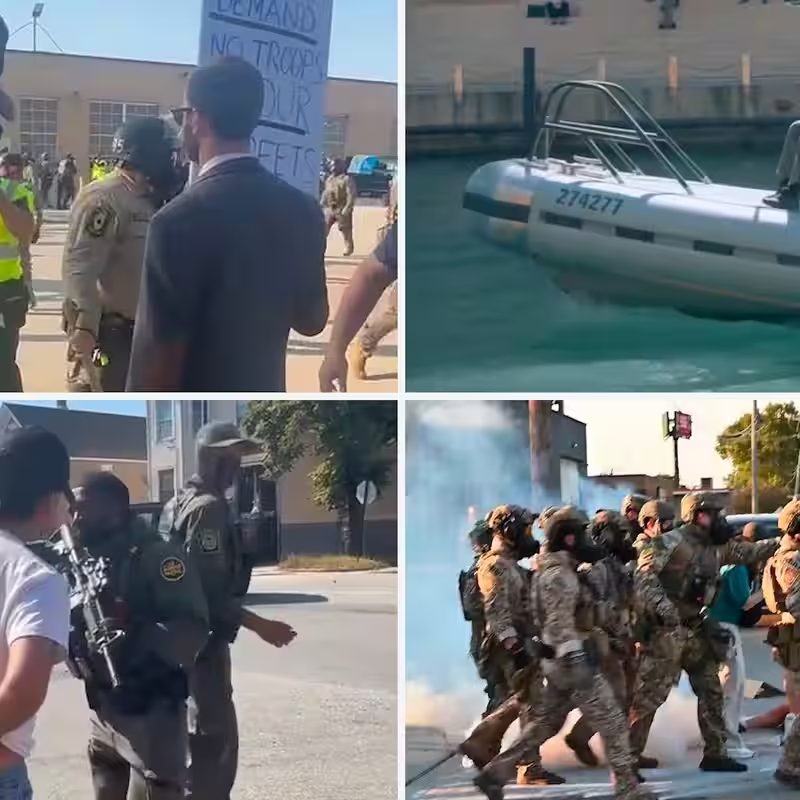Chicago, IL — October 12, 2025 — What began as a targeted federal operation has spiraled into one of the most controversial immigration enforcement campaigns in recent U.S. history. Over the past month, former President Donald Trump’s intensified immigration crackdown in the Chicago area has not only escalated raids and arrests but also ignited fierce public backlash, community fear, and nationwide debate.
Inside the Escalation: A Timeline in 10 Key Moments
From quiet neighborhood sweeps to downtown protests, the federal campaign unfolded in real time—captured in raw, unfiltered video footage that shocked viewers across the political spectrum. Here’s how it escalated, week by week:
- Week 1: ICE agents conduct early-morning raids in predominantly Latino neighborhoods, citing public safety concerns .
- Week 2: Footage surfaces of families separated at dawn—sparking local outcry and emergency city council meetings.
- Week 3: Federal agents deploy alongside National Guard units, a move critics call “militarization of immigration enforcement” .
- Week 4: Hundreds march peacefully through downtown Chicago, demanding an end to what organizers call “state-sanctioned terror” .
- Video 5: A viral clip shows a Chicago police officer refusing to assist ICE agents—highlighting city-county tensions.
- Video 6: Community leaders hold a press conference outside a shuttered immigrant aid center, now under federal investigation.
- Video 7: A child’s tearful plea outside a detention van goes viral, reigniting national conversations about family separation.
- Video 8: Drone footage reveals nighttime convoys transporting detainees to an undisclosed facility in Joliet.
- Video 9: A leaked internal memo suggests coordination between Trump campaign operatives and DHS field offices .
- Video 10: Mayor Brandon Johnson announces Chicago will sue the federal government for “overreach and civil rights violations.”
Why Chicago? The Political Backdrop
Chicago has long been a sanctuary city, limiting cooperation with federal immigration authorities. Trump’s administration has repeatedly criticized this policy, framing it as a threat to national security. “This surge in immigration enforcement activity in the Chicago area is about getting dangerous criminals off the streets,” Trump stated publicly . However, data from local advocacy groups shows that over 60% of those detained had no criminal record.
Community Impact: Fear, Resistance, and Solidarity
Local businesses report declining foot traffic in immigrant-heavy corridors like Pilsen and Little Village. Schools note increased absenteeism among undocumented students. Yet, resistance is growing: mutual aid networks have expanded, legal aid hotlines are overwhelmed with calls, and faith groups are offering sanctuary .
What’s Next?
Legal experts warn the crackdown may violate the Fourth Amendment and Illinois’ TRUST Act, which restricts local law enforcement from aiding ICE without a judicial warrant. Meanwhile, civil rights organizations are preparing class-action lawsuits.
Table: Key Statistics from the Crackdown (as of Oct 12, 2025)
| Metric | Figure |
|---|---|
| Total Detentions | 412 |
| % With No Criminal Record | 63% |
| Protests Held | 17 |
| Legal Aid Requests | +280% vs. Sept |
Sources
- The New York Times: How Trump’s Chicago Immigration Crackdown Escalated, in 10 Videos
- Block Club Chicago: One Month Into Trump’s Immigration Blitz, Chicago Escalates Its Fight Back
- Local protest reports and federal statements




